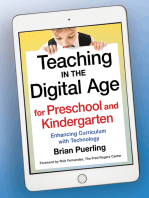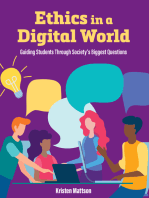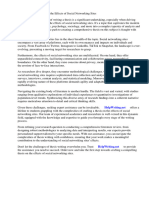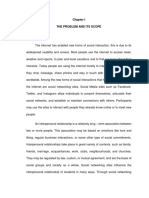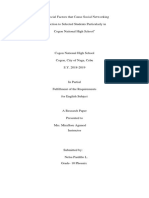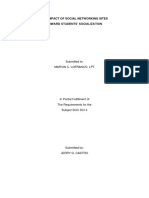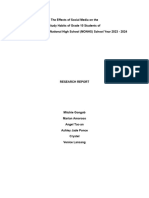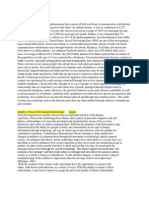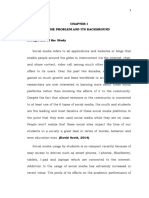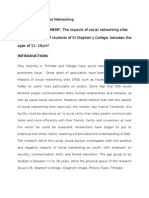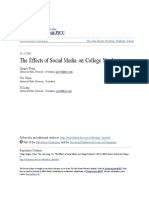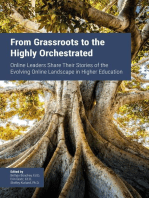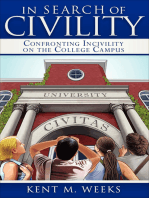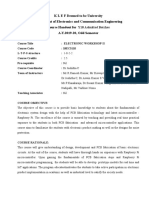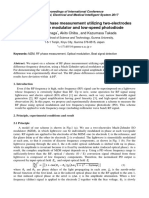The Influence of Social Networking Participation On Student Acade
The Influence of Social Networking Participation On Student Acade
Uploaded by
GlennOcampoCopyright:
Available Formats
The Influence of Social Networking Participation On Student Acade
The Influence of Social Networking Participation On Student Acade
Uploaded by
GlennOcampoOriginal Title
Copyright
Available Formats
Share this document
Did you find this document useful?
Is this content inappropriate?
Copyright:
Available Formats
The Influence of Social Networking Participation On Student Acade
The Influence of Social Networking Participation On Student Acade
Uploaded by
GlennOcampoCopyright:
Available Formats
The College at Brockport: State University of New York
Digital Commons @Brockport
Counselor Education Master's Theses
Counselor Education
2010
The Influence of Social Networking Participation
on Student Academic Performance Across Gender
Lines
Kaitlyn Flad
The College at Brockport, kaitlyn.flad@gmail.com
Follow this and additional works at: http://digitalcommons.brockport.edu/edc_theses
Part of the Student Counseling and Personnel Services Commons
Recommended Citation
Flad, Kaitlyn, "The Influence of Social Networking Participation on Student Academic Performance Across Gender Lines" (2010).
Counselor Education Master's Theses. Paper 31.
This Thesis is brought to you for free and open access by the Counselor Education at Digital Commons @Brockport. It has been accepted for inclusion
in Counselor Education Master's Theses by an authorized administrator of Digital Commons @Brockport. For more information, please contact
kmyers@brockport.edu.
Running head: THE INFLUENCE OF SOCIAL NETWORKING
The Influence of Social Networking Participation
On Student Academic Performance Across Gender Lines
Kaitlyn Flad
The College at Brockport
THE INFLUENCE OF SOCIAL NETWORKING PARTICIPATION
Table of Contents
1. Acknowledgments...3
2. Abstract..4
3. Introduction..5
4. Review of the Literature.7
Social Networking Defined...7
History of Social Networking Technology.8
Adolescents and the Internet...14
Gender Differences and Internet Use18
SNS Drama..20
Cyber-Bullying...21
Peer Pressure...21
High School Academics22
Problems in Schools..24
Parental Involvement24
Benefits of Social Networking25
Summary of the Literature...25
5. Method.26
6. Results..29
7. Discussion...........34
8. References43
9. Appendices..49
THE INFLUENCE OF SOCIAL NETWORKING PARTICIPATION
Acknowledgments
I would like to express my deepest appreciation for those who have helped me
complete this thesis. First and foremost, I am pleased to thank my supervisor, Liz
Tabone, for her contributions to this project and guidance throughout the year.
I also wish to thank the Counselor Education department for their continuous
support and assistance. A special thanks must be given to my clinical supervisor, Dr.
Thomas Hernandez, for providing me with invaluable guidance and unwavering
support as I worked on this project.
Thank you to my classmates and friends who have shared in my successes and
who have stood by me through the challenges. In particular, to my colleague Jenna
Winicki, who has been with me since the beginning. Thank you for the endless support,
millions of phone conversations, and lifelong memories.
The data analysis of this project would not have been completed without the
help of Dave Rigolo, who acted as my math genius and left side of the brain throughout
this experience. The time and energy you have spent helping me will never go
unappreciatedThank you.
To my sister Jennifer, who is not only my best friend but also my role model.
Thank you for your support, encouragement, and for always being confident in my
abilities.
Finally, to my mother, whose kindness and compassion for others has been my
inspiration for entering the field of counseling. Thank you for all you have done to
make my life easier as I worked through this project. I couldnt have done it without
you!
Social media is not a media. The key is to listen, engage, and build relationships.
David Alston
THE INFLUENCE OF SOCIAL NETWORKING PARTICIPATION
Abstract
Participation with technology for social purposes has become the mainstream
communication method for many people in the past several years. In particular,
adolescents in high school have adopted these forms of communication as the
paramount way to keep in touch with family and friends. Social Networking websites,
such as Facebook and MySpace are the most popular places for these students to spend
their time, and are the primary focus of this study. The researcher examined the impact
of social networking participation among a sample of high school students to determine
how this involvement affects academic performance, future plans, and overall attitude
towards school. Differences between male and female students regarding academic
achievement, performance, and social networking use will also be identified and
discussed. Recommendations for school counselors and further studies will be offered.
THE INFLUENCE OF SOCIAL NETWORKING PARTICIPATION
The Influence of Social Networking Participation
On Student Academic Performance Across Gender Lines
The increased use of Social Networking Websites has become an international
phenomenon in the past several years. What started out as a hobby for some computerliterate people has become a social norm and way of life for people from all over the
world (Boyd, 2007). Teenagers and young adults have especially embraced these sites as
a way to connect with their peers, share information, reinvent their personalities, and
showcase their social lives (Boyd, 2007).
I became interested in focusing on social networking sites after meeting with
several eleventh grade students and listening to their stories about things that had
happened on Facebook. The focus in our counseling sessions seemed to revolve around
this website and what the students described as Facebook drama. This drama
included stories about friends posting upsetting messages, posting pictures that were
not supposed to be seen by everyone, and students not being invited to join a group
or party that everyone else seemed to be invited to.
What is fascinating to me is the fact that an Internet invention has become such an
important thing for these students, especially because I did not have Internet access
back when I was in high school. In those days, my friends and I would write notes to
each other and hope that we could find a time to meet during the day just to pass them.
Now, communication is instant. Teens own cell phones that enable them to access social
networking sites throughout the day.
THE INFLUENCE OF SOCIAL NETWORKING PARTICIPATION
Being a counseling intern, I would meet with students weekly and hear about
what was said on-line. So much chaos was occurring for these teens, even though none
of them were face to face for any of it. In my mind I wondered, What is it like to have a
virtual argument with someone? or, What is it like for everyone to know I am having
an argument because it is posted all over a website? It was easy for me to see how this
site did create drama for students and also how these social networking sites can
affect their mental health and well being. Students would miss class, and access
counseling services because of events that occurred the night before while on Facebook
or another social networking site. When I really thought about it, I wondered how
many students were missing classes, staying home from school, or avoiding school
work in order to participate on social networking websites. In the end, all of these
things would negatively impact their overall academic performance.
In the past five years, much research has been done on the emotional
consequences of social networking site participation, but not much has been studied on
the academic outcomes. I chose to do this research study because I think attention must
be placed on high school students and the relationship between social networking
involvement and their academic performance. I also wanted to understand how gender
impacted this study, since male and female students may have different reasons for
participating in social networking, and may have different academic practices.
Since most recent research on social networking websites has been done on
college students, the review of literature is divided into several parts. First, I will
discuss social networking sites; What they are and how important they have become in
THE INFLUENCE OF SOCIAL NETWORKING PARTICIPATION
our society. The history of social networking will be explored, as well as how these
websites have become a staple of mainstream society. Then I will review the research on
adolescents, their Internet usage, and how these sites may affect them socially and
emotionally. The following part will examine high school students and how their
communication may differ through direct and technological communication based on
gender. The following three sections will discuss some of the problems associated with
social networking sites, including social networking drama, the rise of cyber-bullying
and adolescent peer pressure. The next section examines the academic struggles that
high school students are currently facing and how communication technologies like
social networking sites play a part in schools. The final three sections will focus on
parental involvement, the benefits of social networking in the lives of teenagers, and the
summary of the literature. At the end of this research project, I hope to tie all of these
parts together to discuss adolescent social networking site participation and how this
may affect academic achievement in male and female high school students.
Review of the Literature
Social Networking Defined
The idea of Social Networking has existed for several decades as a way for
people to communicate in society and build relationships with others (Coyle & Vaughn,
2008). With the increase of technology used for communicating with others and the
popularity of the Internet, Social Networking has become an activity that is done
primarily on the Internet, with sites like MySpace, Facebook, Bebo, Friendster, and
Xanga (Coyle & Vaughn, 2008). Social networking sites (SNS) may be defined as:
THE INFLUENCE OF SOCIAL NETWORKING PARTICIPATION
Web-based services that allow individuals to (1) construct a public or semi-public
profile within a bounded system, (2) articulate a list of other users with whom
they share a connection, and (3) view and traverse their list of connections and
those made by others within the system (Boyd & Ellison, 2007, 1).
History of Social Networking Technology
In the early 1990s, online communication technologies were introduced to the
public in forms such as email and chat rooms (Peter & Valkenburg, 2009). Many
authors, such as Dr. Norman Nie of Stanford University, predicted that these forms of
technology would negatively impact adolescent social lives, and reduce their sense of
well-being (Peter & Valkenburg, 2009). At that time, many child and adolescent
researchers thought that on-line relationships would be superficial or meaningless. It
was also predicted that these teenagers would use the Internet for purposes of meeting
strangers instead of building on established relationships (Peter & Valkenburg, 2009). It
was also assumed by some professionals that adolescents would spend too much time
on computers, and this would negatively affect their real- life friendships and
relationships with others (Peter & Valkenburg, 2009).
While several authors during the early 2000s hypothesized that children and
teenagers would become less social with on-line participation, proving this was
difficult, as many homes still did not have Internet access. In 1995, it was estimated that
only 11% of American teenagers were actively participating on social networking
websites (Peter & Valkenburg, 2009).
THE INFLUENCE OF SOCIAL NETWORKING PARTICIPATION
Since the early years of social networking popularity, research has been done in
order to find out how this technology was affecting youth (Bryant, Sanders-Jackson, &
Smallwood, 2006). Though the early trend was to believe that these sites would
negatively affect adolescent communication, other researchers believed that
technological communication would benefit many teenagers who had trouble
expressing their thoughts and feelings face-to-face (Bryant, Sanders-Jackson, &
Smallwood, 2006). Though the argument continues to be studied and analyzed, it is still
a question that many researchers want answered. By looking at the most popular social
networking devices, several conclusions can be made as to why these social tools are
popular with young adults.
AOL Instant Messenger
The introduction of America On-line (AOL) Instant Messaging (shortened to
AIM) in 1997 greatly increased the number of adolescent on-line participation (Peter
& Valkenburg, 2009). AIM was one of the first on-line communication technologies that
encouraged users to communicate with existing friends in real-time. In order to have
an on-line conversation with another person, a user would have to send an add
invitation to another user, which would then have to be accepted by that person,
acknowledging that he or she was an existing friend (Peter & Valkenburg, 2009). Each
user creates his or her own screen name which, for most, was either the users first
name followed by numbers or a fictional name or word. When using AIM, each user
THE INFLUENCE OF SOCIAL NETWORKING PARTICIPATION
10
has his or her own buddy list which displays the current screen names of the people
he or she knows and is able to chat with (Peter & Valkenburg, 2009).
In the early stages of AIMs popularity, users would have to use a phone line in
order to use the program, as this was the only means of gaining Internet access. Once
the Internet was able to be accessed through cable and broadband connections, users
would be able to keep the Internet running as long as they wanted, which allowed them
to send and receive messages throughout the day (Peter & Valkenburg, 2009). This
acted as a way to communicate with others even when a friend or family member was
not currently sitting at their computer. Away Messages were created to inform others
of what a user is doing when not currently online. If a user tried to send an instant
message to a friend, these away messages would be sent back to that user, alerting him
or her that the message was received, but that user is away from the computer at the
moment (Peter & Valkenburg, 2009).
AIM was one of the first on-line programs that introduced adolescents to the
world of cyber-communication. Researchers have found that AIM became a household
name by the late 1990s, and was used by over 50% of American teenagers (Peter &
Valkenburg, 2009). By 2007, this number rose to approximately 84%, as more and more
families have Internet access in their homes (Peter & Valkenburg, 2009).
In a study completed in 2006, researchers investigated adolescent interest in AIM
and the primary reasons for using this system rather than speaking face-to-face with
others (Bryant, Sanders-Jackson, & Smallwood, 2006). This study found that 92% of
THE INFLUENCE OF SOCIAL NETWORKING PARTICIPATION
11
teens reported using AIM to connect with friends and make plans. Other reasons for
using this program included playing games with instant messaging software, asking
someone out, and breaking up with someone (Bryant, Sanders-Jackson, & Smallwood,
2006). Alongside these responses were also an alarming number of negative
explanations such as playing on a trick on someone (60%), and Writing something I
wouldnt say in person (42%), which gave researchers insight as to the possible social
consequences of using this system (Byrant, Sanders-Jackson, & Smallwood, 2006).
AOL Instant Messaging paved the way for what is now the way that method
used by most adolescents in order to communicate with others. Instead of face-to-face
interactions, adolescents use websites and other forms of social technology to chat
and send messages to people they know, and to network with others to meet new
people (Peter & Valkenburg, 2009). Following AIMs popularity with children, teens,
and adults alike, social networking websites were created that offered people more
ways to communicate and stay in touch.
Social Networking Sites
Social Networking Sites (SNS) have been popular since the year 2002 and have
attracted and fascinated tens of millions of Internet users (Boyd & Ellison, 2007).
Though only a few have gained worldwide publicity and attention, the Federal Bureau
of Investigation estimated that there are over 200 different sites that are used for social
networking (Duven & Timm, 2008). Most people who are members of these sites, such
as Facebook (over 400 million users) and MySpace (over 100 million users) participate
THE INFLUENCE OF SOCIAL NETWORKING PARTICIPATION
12
in them on a daily basis (Duven & Timm, 2008). Each person who becomes a member of
a SNS has the opportunity to create his or her own webpage or profile which is
supposed to be seen as a reflection of that persons personality (Tufekci, 2008). By using
this personal profile, one can build an entire social network based on his or her own
personal preferences (Boyd & Ellison, 2007).
The idea behind most of this phenomenon, as with many websites, is to help
people feel socially connected and part of a community, even though they may be
sitting home alone at their computer (Coyle & Vaughn, 2008). Participants may connect
with other people they know through school, work, or an organization, or they may
meet complete strangers from all over the world (Coyle & Vaughn, 2008). They do this
by searching for people and adding them as friends so that they may share
information with them and other networks that those people may be a part of (Boyd &
Ellison, 2007). Being friends in the SNS world simply means that two profiles have
been linked together (Tufekci, 2008). This, in turn, expands a persons network greatly,
so that they may meet and share information with even more members (Coyle &
Vaughn, 2008).
In addition, being friends with someone on a SNS allows a person to
communicate in a variety of ways such as sending private and public messages,
participating in on-line games, commenting on photos that have been posted, sharing
music or movie preferences, responding to journal entries, and much more
(Livingstone, 2008). In one authors opinion, Creating and networking online content is
THE INFLUENCE OF SOCIAL NETWORKING PARTICIPATION
13
becoming an integral means of managing ones identity, lifestyle and social relations
(Livingstone, 2008, 394).
A click of a button may mean the loss or gain of a friendship, and a friendship on a SNS
may be with someone who is not a friend in real life (Livingstone, 2008).
Though there are several options for privacy on these sites, research has shown
that the public aspect of sharing information is what draws many to join and participate
(Duven & Timm, 2008). Privacy has a new definition when referring to Social
networking sites, since just becoming a member requires a person to give certain
personal information (Duven & Timm, 2008). Some sites, like Facebook, started as a
way for college students to connect and having an edu email address was required
for signing up (Tufekci, 2008). Now, this site is open for all users, which also increases
the amount of people who may have two accounts: One for private use, and one for
business or school use (Tufekci, 2008).
When conceptualizing why these sites appeal to so many people, it is significant
to note that each SNS focuses on the presentation of self and social status (Tufekci,
2008). Each person who joins a SNS must choose a picture to post on their personal
profile, which is the picture that will be used as a representation of themselves (Barker,
2009). Some people use a recent picture of their face or a photo of a group of friends,
while others choose a different image that they want to represent them or their values
(Barker, 2009). Either way, this picture is significant when looking at a SNS because it
shows how each individual would like to be seen by others (Barker, 2009).
THE INFLUENCE OF SOCIAL NETWORKING PARTICIPATION
14
Social status is also a very important part of SNSs because it is plays a role in
how each individual is viewed on their profile by others (Tufecki, 2008). Most SNSs will
show how many friends a person has, as well as how many people have written to
that person lately (Tufecki, 2008). Because of this, many SNS members will seek out
people to connect with, even though they may not personally want to be linked with
specific people (Tufecki, 2008). Adolescents and college-aged individuals are especially
interested in having a lot of friends, because many worry what others will think if they
do not have as many friends as their peers (Barker, 2009).
Not only does joining a SNS help gain and preserve popularity, but selecting the
perfect pictures to post are also very important aspects of the experience (Siibak, 2009).
According to a recent study done on visual impression management and social
networking sites, approximately 60% of adolescents will spend more time selecting
which pictures to post on their profile than actually communicating with others (Siibak,
2009). This shows that these SNSs are not just for keeping in touch with classmates and
meeting new people, they are used to build adolescent identities (Siibak, 2009). Because
social networking sites are used primarily by adolescents and young adults, the next
section will discuss this group of individuals and their Internet use.
Adolescents and the Internet
In the beginning years of personal computers and Internet access, websites were
used primarily for information gathering and research (Alexander & Salas, 2008). In the
past several years, the Internet has become the center of communication between
THE INFLUENCE OF SOCIAL NETWORKING PARTICIPATION
15
people, as well as being their prime source of entertainment (Alexander & Salas, 2008).
It has also become the tool used for almost every project or paper that a student will
write in high school, and in their later years in college (Alexander & Salas, 2008). In
recent studies, adolescents have shown to be the greatest consumers of the Internet,
particularly for social interactions (Lin & Subrahmanyam, 2007). Social networking
sites, as well as email, instant messaging, blogging, and online journals have completely
changed the way that adolescents interact and gather information (Raacke & Raacke,
2008).
Adolescents have become accustomed to this lifestyle much more than older
generations have in recent years, as this way of living is all they know (Lewis, 2008).
Teenagers now use the Internet for the majority their daily activities and information
gathering, as opposed to older generations who used resources like the television or
newspaper (Lewis, 2008). A recent survey showed that approximately ninety percent of
teens in the United States have Internet access, and about seventy-five percent of these
teens use the Internet more than once per day (Kist, 2008). This study also showed that
approximately half of all teens who have Internet access are also members of social
networking sites, and use the Internet to make plans and socialize with friends (Kist,
2008). As one researcher stated, Teens use [the Internet] as an extension of their
personality, to show their friends-and the world- who they are, what they care about,
and to build connections with other like-minded people (Goodman, 2007, 84). It is
THE INFLUENCE OF SOCIAL NETWORKING PARTICIPATION
16
estimated that the vast majority of teenagers in the United States visit at least one social
networking site approximately twenty times each day (Peter & Valkenburg, 2009).
There is often controversy as to whether or not adolescents should be able to
freely use the Internet for communicating with others (Tynes, 2009). Parents in
particular are strongly cautioned by the media and school officials about online
predators and the influence of certain websites on teenagers (Tynes, 2009). They may
use Internet services such as CyberNanny to block certain websites and keep records of
what their children may be looking at on the Internet (Tynes, 2009). Other parents make
house rules about when the Internet may be used or insist that the computer be located
in a central area of the house so that they may monitor what is being looked at by their
teen (Tynes, 2009).
Social networking sites have also been in the center of concern for many parents
because of safety concerns and/or risks (Tynes, 2009). Other parents just simply do not
want their children staring at the computer too long. The risks and dangers of teen
Internet usage are constantly flooding television shows, newscasts, and magazines,
always warning parents to educate parents on teen Internet behaviors (Tynes, 2009).
Sharing inappropriate information or disclosing too much information is
another concern that many adults have about teens that participate in social networking
online (DeSouza & Dick, 2008). In a recent study done on teens and their MySpace
participation, it was estimated that at least 65% of teens who had a MySpace account
had very personal information on their profile pages (DeSouza & Dick, 2008). This
THE INFLUENCE OF SOCIAL NETWORKING PARTICIPATION
17
personal information included where they live, their phone number and email
addresses, where they attend school, where they work, and a number of things that
they enjoy doing in their spare time (DeSouza & Dick, 2008). Also, many teens,
especially females, posted information about their sexual behavior and their alcohol and
substance use (DeSouza & Dick, 2008).
On the other side of the issue, there are other adults and many professionals,
including teachers and school faculty, who encourage the use of social networking sites
like Facebook because they allow students to connect with one another and discuss
school related issues (Alexander & Salas, 2008). Teens can form online communities in
order to plan for a project, have group discussions about class material, or use the SNS
as a way to keep in contact when a student has been absent and needs to be updated on
current academic information (Alexander & Salas, 2008).
In response to the question of how much time that adolescents are spending on
social network websites, is significant to note that there other parents who are in favor
of these sites (Bryant, Sanders-Jackson, & Smallwoood, 2006). Some parents are
concerned about their teens social lives and are grateful that they may have an outlet
for their potential depression and loneliness (Bryant, Sanders-Jackson, & Smallwood,
2006). In a study completed in 2006, almost 35% of parents of adolescents reported that
they feel that communication with others, in any form, is better than having no
communication at all, and therefore are fully supportive of their childs Internet use
(Bryant, Sanders-Jackson, & Smallwood, 2006).
THE INFLUENCE OF SOCIAL NETWORKING PARTICIPATION
18
Gender Differences and Internet Use
When reviewing the literature related to gender and adolescents, results are mixed as to
which group spends more time on the Internet (Lin & Subrahmanyam, 2007) Studies
have shown that boys have been online more than girls in previous decades because of
earlier forms of technology such as video or computer games (Lin & Subrahmanyam,
2007). Girls have reported that they use the Internet for things like chatting and
downloading music (Giles & Price, 2008). Because of this, one may hypothesize that
girls will be more likely to be attracted to social networking sites and other online social
groups (Giles & Price, 2008). According to most research done on the topic, the amount
of teenage girls and boys who are communication on these social networks are equally
divided (Bonds-Raacke & Raacke, 2008).
Research has shown that though girls and boys are both likely to have a SNS
account, the reasons for the accounts may vary based on gender (Bonds-Raacke &
Raacke, 2008).For girls, social networking sites are primarily places to reinforce preexisting friendships; for boys, the networks also provide opportunities for flirting and
making new friends (Bonds-Raacke & Raacke, 2008) Girls are also more likely than boys
to post sexually explicit pictures of themselves, and to talk about sexual activity in
public forums (Rafferty, 2009). However, boys are more likely to create an account
simply because they are trying to meet a significant other, or because they are already in
a relationship with someone who has requested them to join (Bonds-Raacke & Raacke,
2008).
THE INFLUENCE OF SOCIAL NETWORKING PARTICIPATION
19
Adolescent girls are also more likely than boys to share personal information
about their daily lives (Merten & Williams, 2009). Results of a recent study involving
Facebook, MySpace, and Xanga showed that though most teenagers aged 13-17 used
these sites for fun and positive reasons, 55% of girls shared personal stories about
depression, anxiety, and relationship problems (Merten & Williams, 2009). Only 15% of
boys shared any personal information besides their hobbies, interests, and friendships
(Merten & Williams, 2009). This study also showed that adolescents use SNSs when
dealing with a death of a peer, and use forums and member profiles to help their
grieving process (Merten & Williams, 2009).
In a recent study, it was shown that adolescent boys seem to benefit more from
Internet use and communication technology than girls do (Peter & Valkenburg, 2009).
This was hypothesized because boys tend to have more difficulty expressing their
thoughts and emotions face-to face with others than girls do (Peter & Valkenburg,
2009). As previously mentioned, the early stages of social networking included web
technology such as AIM, which helped many adolescents chat with others on the
computer instead of in person (Peter & Valkenburg, 2009). The amount of teenagers,
both male and female, participating on social networking on SNSs is staggering, and
this may explain why certain problems arise from these sites that have became a major
problem in todays society.
THE INFLUENCE OF SOCIAL NETWORKING PARTICIPATION
20
SNS Drama
The lack of privacy on SNSs can cause many problems in an adolescents life.
Among the networks of people who are linked together on these sites, there is little that
is not shared (DeSouza & Dick, 2008). Anything written on the site can be viewed by
others, and this can often cause conflict (DeSouza & Dick, 2008). For example, if a teen is
browsing through some of her classmates profile pages and notices that they all went
to a party the night before and she was not invited. Though this could happen even
without SNSs, it makes it much easier to find out what other people are doing just by
the click of a button (DeSouza & Dick, 2008).
Another common problem that this lack of privacy creates is the posting of
relationships on individual profiles (Karl & Peluchette, 2008). Imagine an adolescent girl
has just been broken up with by her boyfriend, and then reads on his profile page that
he has a new girlfriend that same day. Again, this could happen regardless of an
Internet site, but SNSs make everyones personal business very public and easy to find
(Livingstone, 2008). What is also interesting about SNSs is that even though the majority
of members understand that they are public spaces, they still think that they are safe
from unwanted people looking at their information (Karl & Peluchette, 2008). Just like
anything else on the Internet, these types of sites are not always secure, and information
has a way of being sent from one person to another without prior warning (Karl &
Peluchette, 2008).
THE INFLUENCE OF SOCIAL NETWORKING PARTICIPATION
21
Cyber-Bullying
Participating in online social networks also increases the likelihood of being
victimized online, or, cyber-bullied (Mesch, 2009). Cyber-bullying is the use of
communication technology, such as SNSs, to harm or bully others (Mesch, 2009).
Forms of cyber-bullying include harassing emails, web pages, hateful instant messages,
text messages, and cruel posts on social networking sites (Mesch, 2009). The result of
being a victim of cyber-bullying can be embarrassment, feelings of belittlement, low self
esteem, and even suicide (Mesch, 2009).
Because the Internet allows teens to remain anonymous on websites or create
false profiles, cyber-bullying has become a serious issue (Mesch, 2009). One national
poll showed that over 13 million children between the ages of 6 and 17 have reported
victims of cyber-bullying (Mesch, 2009). Research has also shown that an adolescent is
more likely to harass or harm another student if they are not face to face, which also can
make a SNS a perfect place to trouble to manifest (Mesch, 2009). However, there is no
current legislation that protects students from this type of harassment, even though
there are laws for more traditional types of bullying (Geach & Haralambous, 2009).
Peer Pressure
According to recent research about social networking sites and Internet usage by
adolescents, social networking sites like Facebook and MySpace have become so
popular that many high school students will get an account even if they do not want to
THE INFLUENCE OF SOCIAL NETWORKING PARTICIPATION
22
(Peter, Schouten, & Valkenburg, 2006). This shows that joining a SNS signifies more than
just going on a website; it is way of fitting in with peers, just like many other types of
groups in high school (Peter, Schouten, & Valkenburg, 2006). In fact, SNSs may be
predictors of self esteem and well-being in adolescence, and they have become a
fundamental role in adolescent life (Peter, Schouten, & Valkenburg, 2006). As one teen
stated in a research study by Dr. Danah Boyd at Berkeley University: If youre not on
MySpace, you dont exist (Boyd, 2007, 1)
High School Academics
Though there have been many social, economic, and environmental factors that
have added to the pressure of high school students in the past ten years, the drop-out
rate for students is still a major national problem (Bowen, 2008). Current statistics show
that high school students in the United States are under increased pressure due to
higher academic standards in many parts of the country, and it has become more
important than ever for educators to encourage graduation and further education
(Bowen, 2008). However, with more and more adolescents being preoccupied with
social networking sites and technological social lives, how will this affect their studies?
It is estimated that even those students who do graduate high school, one out of three
does not have possess the knowledge and skills that would lead him or her to the next
level, such as college or an advanced trade school (Bowen, 2008).
THE INFLUENCE OF SOCIAL NETWORKING PARTICIPATION
23
The top academic areas that many school professionals are concerned about are
English (ELA) and advanced literacy (Williams, 2008). The current generation of teens
live in a fast-paced technological world with many different types of communication
happening all at the same time. For example, he or she may be on the computer on a
SNS, while also talking on the phone, sending instant messages to a friend, and
emailing someone else all at the same time (Williams, 2008). While there may be some
advantages to this, such as the teen learning how to type faster and multi-task many
things at once, there may also be a breakdown in much of that communication
(Williams, 2008).
Literacy has also taken a dive in the past decade, which has caused many
educators to question what can be done to help students improve their reading, writing,
speaking, and thinking- all of the most basic skills for a successful future (Wise, 2009).
As one researcher stated, Literacy is, in reality, the cornerstone of student achievement,
for any student, in any grade (Wise, 2009, 373). The question that many school
professionals have with regards to communication is whether or not a high school
student is able to follow school curriculum in subjects like English or Language Arts
(Williams, 2008). Also, will it be possible to teach them without the use of multi-tasking
and using new forms of technology?
THE INFLUENCE OF SOCIAL NETWORKING PARTICIPATION
24
Problems in Schools
Social networking sites, as well as other new forms of communication
technology, are also a concern to many school professionals because of the level of
distraction they create within the school (Greenfield & Subrahmanyam, 2008). Even
though many schools have created many strict rules that forbid the use of handheld
technology during school or that block certain social networking websites, many
adolescents are still able to connect during school hours as they please (Greenfield &
Subrahmanyam, 2008). This has caused distractions during instruction time and has had
a negative impact on the learning environment.
Parental Involvement
Parent- child conflicts have also become more of an issue since the sudden
escalation of online social networking (Greenfield & Subrahmanyam, 2008). Research
has shown that children who have a strong sense of communication and closeness with
one (or more) parent or guardian have a better chance at academic success (Greenfield
& Subrahmanyam, 2008). With adolescents hooked on the Internet and other forms of
technology and their language changing with new acronyms and code words that can
only be learned through this technology, the gap between parents and children has
gotten larger (Greenfield & Subrahmanyam, 2008). Many parents do not understand
their teenagers, and cannot find a way to relate to their virtual worlds. This, in turn,
causes distress in the household and may ultimately lead to a barrier between parent,
THE INFLUENCE OF SOCIAL NETWORKING PARTICIPATION
25
child, and communication about school work and grades (Greenfield &
Subrahmanyam, 2008).
Benefits of Social Networking
Though many arguments can be made about the possible risks of adolescent
social networking, it is important to point out the benefits of these websites as well.
Many schools have started to use these sites to promote education, keep students up to
date with assignments, and offer help to those in need (Boyd, 2007). In general, the
Internet and social networking sites can be a positive influence on adolescents. Social
networking sites provide an outlet for teens to express themselves in their own unique
ways (Boyd, 2007). In addition, they serve both as a meeting place for teens to interact
with other like-minded people and as showplaces for a teens artistic and musical
abilities (Boyd, 2007). Finally, high school students use these sites as tools to obtain
information and resources for graduation preparation and future planning. For
example, students applying for college visit profiles of that colleges students to view
pictures and read blogs of past students to determine whether the college would be a
good fit (Boyd & Ellison, 2007).
Summary of the Literature
There are many issues concerning high school students and social networking
site participation. On one hand, there may be benefits for students who use these sites
properly and appropriately. Other research suggests that there are clear risks involved
THE INFLUENCE OF SOCIAL NETWORKING PARTICIPATION
26
when adolescents become too consumed with the Internet and social networking
websites. For the purposes of this research project, I will examine the reasons that high
students use these sites, how often they use them, and how this is affecting their
academic studies. A comparison will also be made between male students and female
students, since much research has shown a difference in SNS participation based on
gender. At the conclusion of this research project, a better understanding will be had
regarding high school students and whether or not they are able balance a life of social
networking and academic performance.
Method
Overview
This research project was created to measure and assess the amount of time the
average high school student would spend on social networking websites, whether or
not these activities were impacting their grades and school work, and how important
social networking was to them in comparison to their academics. Because of this, the
researcher needed students to be the primary source of information. This section will
describe the participants selected to participate in the study, the procedure used to
measure and evaluate participants, and the course of action taken by the researcher to
ensure confidentiality.
THE INFLUENCE OF SOCIAL NETWORKING PARTICIPATION
27
Participant Characteristics
This project was completed at a suburban high school in the northeast United
States. This school is comprised of tenth, eleventh, and twelfth grades and has a student
body of approximately 1500. The gender breakdown of this school is 50.7% female and
49.3% male. Because the researcher was responsible for the eleventh grade class, only
eleventh graders were selected to participate in this study. These students were aged
16-17, and were all expected to graduate in the year 2011. Students were not asked
about their race, ethnicity, socio-economic status, or family history. However, the racial
breakdown of the school consists of 74.8% Caucasian, 14.6% African American, 6%
Asian, 3.7% Hispanic, and .9% American Indian students. All students in this study
were enrolled in general education courses and were not receiving special education
assistance.
Materials Used
A survey was created by the researcher that was composed of 14 questions. The
survey was formatted with yes or no questions, multiple choice questions, and
questions using a Likert-type scale for answering. The survey was expected to take five
to seven minutes to complete.
THE INFLUENCE OF SOCIAL NETWORKING PARTICIPATION
28
Procedures
Students were selected randomly from the school database by the researcher and
an eleventh grade school counselor. These students were all under the age of 18, and
therefore required a parental consent form sent to their parent(s) or legal guardian(s).
These forms required parents or guardians to sign and return the form if they did not
want their child to participate. Once forms were returned to the researcher, student
consent forms were given to students who had permission from their parent or
guardian to participate in the study. Students who signed the consent forms were given
the survey by their study hall teacher at the end of the school day, and these teachers
returned the consent forms and surveys to the researcher the following morning. There
were approximately 63 students who received parental permission to take part in the
study and who were asked to take this survey and 41 of these students did participate.
Protection of Rights
Anonymity was essential in this process in order to ensure confidentiality for all
participants. Though the researcher was aware of which students were given
permission by a parent or guardian to participate in the study, she at no time was
informed of which students chose to take the survey. Students were also reminded on
the survey not to write their names, and that their responses were completely
voluntary. After the researcher received the completed surveys, she did not share this
THE INFLUENCE OF SOCIAL NETWORKING PARTICIPATION
29
information with any other person, and kept them in her possession at all times. The
data from these surveys were destroyed after completion of data entry.
Results
There were 41 students who chose to participate in this research study. Of those
41 participants, 54% were female and 46% were male. When looking at student grade
point averages (GPA), which only gives an idea of student academic performance, the
highest number of students (34%) reported their GPA to be in the 3.0-3.4 range. Twentynine percent reported their GPA to be in the 3.5-4.0 range, 12% reported a GPA between
2.5 and 2.9, 5% reported a GPA between 2.0 and 2.4, and 20% did not know their GPA
or did not know how to calculate their GPA. While comparing grade point averages to
gender, 75% of the students with the highest GPA (3.5-4.0) were female and 25% were
male. Of all female participants, 73% had a GPA of 3.0 or higher, and 53% of male
participants had a GA of 3.0 or higher.
Another measure of academic performance on this survey was the amount of
students in honors and advanced placement (AP) classes. Of the total participants, 73%
had taken or is currently taking an honors level class. Eighty six percent of female
students and 58% of male students had taken at least one honors class. On the other end
of the spectrum, 32% of females and 5% of males have taken five or more honors level
classes. The amount of advanced placement classes that students have taken was also
measured. Of the total participants, 54% have taken at least one AP class. When
THE INFLUENCE OF SOCIAL NETWORKING PARTICIPATION
30
comparing these numbers across gender lines, 64% of these students were female and
36% were male.
Since all of these students were expected to graduate in the year 2011, the type of
diploma they expect to receive was another question that helped to measure academic
achievement between students based on gender. Of the total participants, 70% expect to
be on track for a Regents with Advanced Designation diploma. Of the students who
expect to receive this diploma, 62% were female, 38% were male. Twenty percent of
students expect to receive a Regents Diploma (50% female, 50% male), and 10% expect
to receive a local diploma. The only students on track for a local diploma were male.
In response to the question of post -secondary plans, 88% total participants
answered that they plan to go to college after completion of high school. Only one
student (male) responded that he did not plan to go to college. Ten percent of
participants did not know.
The next questions were intended to gather information on social networking
and the amount of time students spend on these websites. In response to the question of
how many social networking sites a student is a member of, 39% of participants
admitted to having membership to one SNS, 49% had memberships on two SNSs, and
12% responded to having three or more SNS memberships. In addition to using the
computer to access their SNS memberships, 61% use their cell phone for SNS purposes.
Among these students, 60% were female and 40% were male. Of the total participants,
THE INFLUENCE OF SOCIAL NETWORKING PARTICIPATION
31
63% also access their SNS memberships through their email account. When comparing
these numbers with gender, 65% were female and 35% were male.
Table 1
Number of Social Networks versus Student Gender
Gender
Networks
Female
Male
Total
16
11
20
Total
22
19
41
Frequency of social networking was also measured by use of a Likert-type scale
ranging from never visiting a SNS to accessing a SNS more than five times each day. Of
the total student participants, 56% reported to visiting their SNS At least once per
day, 29% answered that they visit a SNS More than five times per day, seven percent
admitted to visiting a SNS At least once per day, and the remaining students reported
to visiting s SNS At least once per month. When looking at differences in answered
based on gender, the most significant finding was that 66% of females reported to
visiting a SNS More than five times per day versus 33% of males.
THE INFLUENCE OF SOCIAL NETWORKING PARTICIPATION
32
The next two questions asked students how often their time spent on a SNS
interfered with their ability to hand in a homework assignment on time, and their
ability to study. Of the total participants, 32% reported Yes to the question of
spending time on a SNS instead of doing homework, and 68% answered No. Of these
students who answered, Yes,69% were female and 31% were male. When answering
the question of spending time on a SNS instead of studying, 34 of all participants
answered that they have spent time on a SNS Several times instead of studying, 22%
answered, More than one time, 12% answered One time, and 34% reported to
Never spending time on a SNS instead of studying. Of the students who answered
Several times to this question, 77% were female and 23% were male. Eighty-six
percent of the students who responded Never to this question were male, and 14%
were female.
The next question was in True or False format and asked the participants, What
I learn on a social networking website is more important than most of the things I learn
at school. Seventeen percent of all students responded True, and 83% answered,
False. Of the students who responded with True, 86% were female and 14% were
male.
The final question asked students to rate the importance of their social
networking membership(s) from Not important to Very important. Ten percent of
the total participants responded Very important, 17% answered Important, 34%
responded Somewhat important, and 39% rated their SNS membership(s) as Not
THE INFLUENCE OF SOCIAL NETWORKING PARTICIPATION
33
important. One hundred percent of students who reported their SNS membership to
be Very important were female. Forty-five percent of females reported that their SNS
membership(s) were important/very important (vs. 5% of males). In total 61% of all
participants view their SNS membership(s) as at least Somewhat important.
When comparing student GPA and the students who answered Yes to the
question regarding learning more on social networking websites than in school, it is
significant to note that 18% of these students do not know their GPA. As expected, 88%
of the students who have a GPA of 3.0 or higher responded False to this question.
Another significant correlation was made between student frequency of time
spent visiting a SNS and the amount of times that they have spent time on a SNS
instead of studying or completing assignments. Of the students who responded that
they visit a SNS more than five times per day, 50% have also reported that they have
spent time on a SNS More than one time or Several times instead of studying or
completing assignments.
Seventeen percent of students who answered True to the question, What I
learn on a social networking website is more important than most of the things I learn at
school. Of these students, 57% also reported that their membership to a SNS was not
important. Twenty-nine percent of these students answered that their SNS
memberships were Important or Very Important.
THE INFLUENCE OF SOCIAL NETWORKING PARTICIPATION
34
The results to the survey were analyzed using correlations between academic
attitudes and performance, gender, and social networking frequency, opinions, and
importance. The next section will explore the meanings behind these results and will
discuss the significant findings of the data reported by participants.
Table 2
Social Networking Importance versus Gender
Gender
Importance
Not Important
Female
7
Male
9
Total
16
Somewhat Important
14
Important
Very Important
Total
22
19
41
Discussion
Overview
The results of the survey show a variety of different themes relating to
adolescent use of social networking websites, academic practices and attitudes, and the
differences between male and female respondents. The review of literature highlighted
areas of interest to the researcher that will be reflected upon when interpreting the data.
The finding that social networking is of great importance to adolescents is consistent
THE INFLUENCE OF SOCIAL NETWORKING PARTICIPATION
35
with the literature, as is the idea that there are differences between male and female
students regarding academics and social networking.
This section will interpret these results and discuss the relationship between this
study and previous academic research. Limitations of this study will be identified and
discussed, as well as recommendations for school counselors and other professionals
who wish to explore this topic in the future.
Interpretation of Findings
Academics
Research on high school graduation requirements has shown that students are
under increased pressure to excel academically (Bowen, 2008). Of the students who
participated in this study, only two students (approximately 5%) reported the
expectation of a local diploma. All other students expect a Regents or Regents with
Advanced Designation diploma. When interpreting these data, it is apparent that the
students in this study were performing at average or above average academic standards
compared to the school as a whole. The participants had an average GPA between 3.0
and 3.4, and were all expected to graduate on time with their class.
When comparing academic performance between genders, the students with the
highest GPAs were female, and the students with the lowest GPAs were male. The
vast majority (88%) also reported to wanting to go to college after graduation. The only
student who reported not wanting to go to college was male. A higher percentage of
THE INFLUENCE OF SOCIAL NETWORKING PARTICIPATION
36
female students were also enrolled in Honors and AP classes than males. This
difference between male and female students is consistent with the literature reviewed
for this project. In a study of national graduation rates in 2006, one researcher found
that females were performing better than males in all core areas of high school curricula
(Greene & Winters, 2006). This study also showed that 72% of female students
completed high school that year compared to 65% of male students (Greene & Winters,
2006). These findings may explain why another researcher stated that it has become
commonplace in this country that more females than males are attending college
(Williams, 2008). It was hypothesized in this study that males tend to choose careers
that require less education than females do, and therefore do not have as much
motivation for higher education (Williams, 2008).
Though some research has shown that the gap between male and female high
school achievement has widened, another researcher found that female and male
students may simply be different in their learning styles (Bowen, 2008). In a study
completed in 2008, this researcher found that males and females may be more
successful in different classes or areas of study, but their grades are still comparable
(Bowen, 2008). Statistics on high school achievement and performance vary by state,
and are therefore difficult to generalize to the entire population (Bowen, 2008).
Social Networking Participation
All students who completed the survey admitted to having a membership on one
or more social networking websites. This is consistent with the literature regarding SNS
THE INFLUENCE OF SOCIAL NETWORKING PARTICIPATION
37
popularity. Research has shown that there are now more than 500 million people with
Facebook memberships, and most of these people are members of other sites as well
(Boyd & Ellison, 2007). The results of the survey also show that students visit these sites
at least once per day.
In addition to using the computer to visit sites like Facebook and MySpace, 61%
of students answered yes to accessing their SNS memberships through their email or
cell phone. This implies a strong interest in keeping in touch with people through social
networking. However, when students were asked the true or false question, What I
learn on a social networking website is more important than most of the things I learn at
school, only 17% answered True. This means that though most students spend a lot
of time on these websites, they still realize that what they learn in school is important
for their future goals.
Importance of social networking in the lives of adolescents was a major part of
this project, and the survey questions were created to measure this. However, many
students who reported to having multiple SNS accounts, using them regularly through
computer, email, and cell phone, still reported that their SNS were Not Important.
This is interesting, given the fact that students seem to spend a lot of time on these sites.
Only ten percent of all participants rated their SNS membership(s), Very Important,
and these students were all female.
According to the literature, females are more likely than males to engage in social
networking (Giles & Price, 2008). Though males and females may both have access to
THE INFLUENCE OF SOCIAL NETWORKING PARTICIPATION
38
these websites in various forms, females invest more time in maintaining their accounts
(Giles & Price, 2008). This is consistent with the results of this thesis, since females
reported to having more SNS accounts, visiting them more than once per day, and
admitting that their memberships often get in the way of school work. As one
researcher stated, adolescent females use their SNS accounts to maintain friendships
and keep in touch with classmates, and males tend to browse for females (BondsRaacke & Raacke, 2008). Other research suggests that many males have SNS accounts
simply because their girlfriends insisted upon it (Bonds-Raacke & Raacke, 2008).
Impact of SNS on Academics
The relationship between students who are actively involved in social
networking and their academic performance is inconclusive. Females were more likely
than males to participate in social networking, but were also more likely to have higher
grades and take more rigorous classes. This study has shown that social networking can
have a negative impact on study habits and completion of homework assignments, but
there was not a drastic difference between students who spend a lot of time on these
sites and those who do not. Thirty-four percent of students admitted that they have
spent time on a SNS Several Times instead of studying. Thirty-two percent also
reported that time spent on a SNS has prevented them from completing homework
assignments. Though these numbers are substantial, there is not a causal relationship
between SNS participation and doing poorly in school.
THE INFLUENCE OF SOCIAL NETWORKING PARTICIPATION
39
Limitations
This study is limited with regards to how much information can be generalized
to all high school students. Out of a school with a student body of 1500, only 41
students were able to participate, making it unlikely that all students in the school were
represented from the sample. Eleventh grade students were the only students asked to
participate, which also limited the study to the age group of 16-17. It is important to
note that these students may have differences in academic and social networking
practices than adolescence who are younger or older.
The ratio between male and female students was also not a reflection of the
schools male/female ratio. More female students were surveyed than males, which
provided a limited view of male students.
The survey itself also limited the answers that students could give, as it did not
include any open-ended questions. Students were forced to answer questions based on
the provided answers given in the survey. Self-report bias is also a limitation, as many
students had to answer questions about their own personal practices and opinions.
Recommendations for School Counselors
The results of this project have shown that more attention needs to be placed on
understanding social networking sites and their impact on adolescents. School
counselors need to not only be aware of what sites students are participating on, but
also the significant role that these sites have in the lives of students. Though these sites
THE INFLUENCE OF SOCIAL NETWORKING PARTICIPATION
40
have the potential to distract students from studying, homework, or other academic
requirements, they can also benefit students if used properly and appropriately.
Social networking sites, such as Facebook, are not only gaining popularity each
year, they are becoming the primary form of communication between high school
students when they are at home. Knowing this, school counselors should explore these
sites to find out what attracts students to this type of communication. As the literature
has shown, some adolescents depend on these sites to connect with others and build
friendships (Peter, Schouten, & Valkenburg, 2006). Other research suggests that joining
a SNS is not always an option for adolescents, as many students join simply because of
peer influence (Boyd, 2007).
Advising a student to stop participating in these sites would not be
recommended. As previous studies have shown, these sites are important to adolescent
identity-forming and communication (Tufekci, 2008). School counselors should build
upon the positive attributes that these sites have, such as the ability for students to join
student groups or meet others from school. One way to do this would be to give
classroom presentations on the risks and benefits of social networking, highlighting the
problematic behaviors associated with these sites but also educating students on how
these sites can improve their lives socially and academically.
School counselors should also communicate with parents about their children
and Internet use in the home. Research has shown that there are many parents who are
split between wanting their child to have friends and healthy social lives, and not
THE INFLUENCE OF SOCIAL NETWORKING PARTICIPATION
41
wanting their child spending all their time online (Greenfield & Subrahmanyam, 2008).
School counselors should hold meetings to educate parents on the issues that occur
online, such as cyber-bullying, and how to monitor their childs Internet use. Since
many schools ban the use of social networking during school hours, it is at home that
most of these incidents occur (Greenfield & Subrahmanyam, 2008). Parents also need to
be aware that there are times when their childs social networking participation is
interfering with homework and studying. School counselors can help parents set
boundaries for their children when appropriate and teach them how to talk to their
children about Internet safety.
Recommendations for Future Research
The number of limitations in this study suggests that further research needs to be
done on the influence of social networking participation on student academic
performance and/or attitudes. This research should be done with a large amount of
students and encompass many different grade levels.
In addition to surveying students about how this technology is impact their
academics, much more importance should be focused on how these sites impact their
relationships with other students. Social networking causes more social and behavioral
problems than academic problems and should be addressed. Though adolescents tend
to spend a lot of time on these sites, what is more important than this is what types of
behaviors these teens are engaging in. Qualitative research should be done to find out
how this communication is affecting teens and their relationships with peers.
THE INFLUENCE OF SOCIAL NETWORKING PARTICIPATION
42
Summary
Since their introduction, social networking sites have attracted millions of users,
many of whom who have integrated these sites into their daily lives. Adolescents have
especially embraced this new way of communicating with classmates and keeping in
touch with friends. Though there may be benefits to keeping connected with others by
use of these sites, there is also the danger that they may negatively affect high school
academics and achievement. This study has shown that although many students find
their SNS memberships to be important in their lives, they are also aware of the benefits
of education and completion of high school. Though some admit to spending a lot of
time on these sites, the issue remains to be how they are participating and how this is
affecting their relationships with other students. Communication is rapidly changing,
and more emphasis must be placed on how educators can help students enjoy the
benefits of social networking while also recognizing the problems they may create.
THE INFLUENCE OF SOCIAL NETWORKING PARTICIPATION
43
References
Alexander, J. and Salas, G. 2008. Technology for institutional enrollment,
communication, and student success. New Directions for Student Services, 124,
103-116. doi: 10.1002/ss.298
Atwan, G. and Lushing, E. (2008). The facebook book: A satirical companion.
New York: Abrams Image Publishing.
Barker, V. (2009). Older adolescents motivations for social network site use: The
influence of gender, group identity, and collective self-esteem. CyberPsychology
and Behavior, 12, 209-213. doi: 10.1089/cpb.2008.0228
Bonds-Raacke, J. and Raacke, J. 2008. MySpace and facebook: Applying the uses and
gratifications theory to exploring friend-networking sites. CyberPsychology and
Behavior, 11, 169-174. doi: 10.1089/cpb.2007.0056
Bowen, G. (2008). Preventing school dropout: The eco-interactional developmental
model of school success. The Prevention Researcher, 16, 3-8. Retrieved from
http://www.TPRonline.org
Boyd, D. 2007. Why youth (heart) social network sites: The role of networked publics in
THE INFLUENCE OF SOCIAL NETWORKING PARTICIPATION
44
teenage social life. MacArthur Foundation Series on Digital Learning-Youth,
Identity,and Digital Media Volume. Cambridge, MA: MIT Press. 1-26.
Boyd, D. and Ellison, N. (2007). Social network sites: Definition, history, and
scholarship. Journal of Computer-Mediated Communication, 13(1),1-11. Retrieved
from http://jcmc.indiana.edu/vol13/issue1/boyd.ellison.html
Bryant, J.A., Sanders-Jackson, A., and Smallwood, A. (2006). IMing, text messaging, and
adolescent social networks. Journal of Computer-Mediated Communication, 11,
10. Retrieved from: http://jcmc.indiana.edu/vol11/issue2/Bryant.html.
Coyle, C. and Vaughn, H. (2008). Social networking: Communication revolution or
evolution?Bell Labs Journal, 13, 13-17. doi: 10.1002/bltj.20298
De Souza, Z. and Dick, G. (2008). Information disclosure on myspace- the what, the why
and the implications. Pastoral Care in Education, 26, 143-157
doi: 10.1080/02643940802246427
Duven, C. and Timm, D. (2008). Privacy and social networking sites: New directions for
student services. 124. 89-100. doi: 10.1002/ss.297
Geach, N. and Haralambous, N. (2009). Regulating harassment: Is the law fit for the
social networking age? The Journal of Criminal Law, 73, 241-257
THE INFLUENCE OF SOCIAL NETWORKING PARTICIPATION
45
doi: 1350/jcla.2009.73.3.571
Giles, G. and Price, R. (2008). Adolescent computer use: Approach, avoidance, and
parental control. Australian Journal of Psychology, 60, 63-71
doi: 10.1080/00049530701829896
Goodman, J. (2008) Click first, ask questions later: Understanding teen online behavior.
Australasian Public Libraries and Information Services, 20(2), 84-85. Retrieved From:
http://www.search.informit.com.au
Greene, J. and Winters, M. (2006). Leaving boys behind: Public high school graduation
rates. Civic Report, 48, 1-26. Manhattan Institute for Policy Research.
Retrieved from: http://www.manhattan-institute.org
Greenfield, P. and Subrahmanyam, K. (2008). Online communication and adolescent
relationships. The Future of Children, 18, 119-140. Retrieved from:
http://www.futureofchildren.org
Karl, K. and Peluchette, J. (2008). Social networking profiles: An examination of student
attitudes regarding use and appropriateness of content. CyberPsychology and
Behavior, 11, 95-97. doi: 10.1089/cpb.2007.9927
Kist, W. (2008). I gave up myspace for lent: New teachers and social networking sites.
THE INFLUENCE OF SOCIAL NETWORKING PARTICIPATION
46
Journal of Adolescent and Adult Literacy, 52, 245-286. doi: 10.1598/JAAL.52.3.7
Lewis, S. (2008). Where young adults intend to get news in five years. Newspaper
Research Journal, 29(4), 36-52. Retrieved from:
http://findarticles.com/p/articles/mi_qa3677/is_200810/ai_n39229321/
Lin, G. and Subrahmanyam, K. (2007). Adolescents and the net: Internet use and wellbeing. Adolescence, 42(168), 659-675. Retrieved from:
http://findarticles.com/p/articles/mi_m2248/is_168_42/ai_n27483301/
Livingstone, S. (2008). Taking risky opportunities in youthful content creation:
Teenagers use of social networking sites for intimacy, privacy and self
expression. New Media Society, 10, 393-411. doi: 10.1177/1461444808089415
Merten, M. and Williams, A. (2009). Adolescents online social networking following the
death of a peer. Journal of Adolescent Research, 24, 67-90.
doi:10.1177/0743558408328440
Mesch, G. (2009). Parental mediation, online activities, and cyberbullying.
CyberPsychology and Behavior, 12, 387-392. doi: 10.1089/cpb.2009.0068
Nie, N. H. (2001). Sociability, interpersonal relations and the internet: Reconciling
conflicting findings. American Behavioral Scientist, 45. 420-435.
THE INFLUENCE OF SOCIAL NETWORKING PARTICIPATION
47
Peter, J. and Valkenburg, P. (2009). Social consequences of the internet for adolescents:
A decade of research.Psychological Science, 18(1), 1-4. doi: 10.1111/j.14678721.2009.01595.
Peter, J., Schouten, A., and Valkenburg, P. (2006). Friend networking sites and their
relationship to adolescents well being and social self esteem. CyberPsychology and
Behavior, 9, 584-590. doi: 10.1089/cpb.2006.9.584
Rafferty, F. (2009). Boys should be boys-is it that simple? Education Journal, 116, 32-33.
Rapacki, S. (2007). Social networking sites: Why teens need places like myspace. Young
Adult Library Services. 28-30.
Siibak, A. (2009). Constructing the self through the photo selection- Visual impression
management on social networking websites. Journal of Psychological Research
on Cyberspace, 3(1) 1-6. Retrieved from:
http://www.cyberpsychology.eu/view.php?cisloclanku=2009061501&article=1
Tufekci, Z. (2008). Grooming, gossip, facebook and myspace: What can we learn from
those who wont assimilate? Information, Communication, and Society, 11, 544-563.
doi: 10.1080/13691180801999050
Tynes, B. (2007). Internet safety gone wild? Sacrificing the educational and psychosocial
THE INFLUENCE OF SOCIAL NETWORKING PARTICIPATION
48
benefits of online social environments. Journal of Adolescent Research, 22, 575-584.
doi: 10.1177/0743558407303979
Williams, B. (2008). Tomorrow will not be like today: Literacy and identity in a world of
multiliteracies. Journal of Adolescent and Adult Literacy, 51, 682-686.
doi:10.1598/JAAL.51.8.7
Wise, B. (2009). Adolescent literacy: The cornerstone of student success. Journal of
Adolescent and Adult Literacy, 52, 369-375. doi: 10.1598/JAAL.52.5.1
THE INFLUENCE OF SOCIAL NETWORKING PARTICIPATION
49
THE INFLUENCE OF SOCIAL NETWORKING PARTICIPATION
50
Appendix 1: Data Correlations
Table 3.1
Pearson Correlations Between Survey Questions
Gender
GPA
H_classes
AP_classes
College
Networks
Cell
-.070
-.301
-.166
-.260
-.110
-.159
GPA
-.070
.538**
.206
.383*
-.056
-.204
H classes
-.301
.538**
.404**
.335*
-.240
-.215
**
.081
-.163
.060
.335
.081
-.023
-.281
Gender
AP_classes
-.166
.206
College
-.260
.383
Networks
-.110
-.056
-.240
-.163
-.023
.276
Cell
-.159
-.204
-.215
.060
-.281
.276
**
**
.290
.098
-.018
.015
-.310
Freq
-.242
.107
.103
.072
-.058
.089
.395*
Late
-.213
-.111
-.171
.287
-.138
-.009
.223
Study
-.497**
.042
.227
.373*
-.043
.015
.487**
.292
.254
.116
.186
-.004
-.282
-.230
.221
-.075
.111
.086
.339*
Opinion
Importance
-.378
.518
.404
.366
.533
Note. `*. Correlation is significant at the 0.05 level (2-tailed).
THE INFLUENCE OF SOCIAL NETWORKING PARTICIPATION
51
Table 3.2
Pearson Correlations Between Survey Questions
Freq
Late
Study
Opinion
Importance
Gender
-.310*
-.242
-.213
-.497**
.292
-.378*
GPA
.518**
.107
-.111
.042
.254
.366*
H_classes
.533**
.103
-.171
.227
.116
.221
AP_classes
.290
.072
.287
.373
.186
-.075
College
.098
-.058
-.138
-.043
-.004
.111
Networks
-.018
.089
-.009
.015
.015
.395
Freq
-.282
.086
.223
.487
**
-.230
.339*
.350*
.191
.351*
.194
.448**
.350*
.000
.347*
-.128
.395*
Late
.191
.000
.433**
-.109
.340*
Study
.351*
.347*
.433**
-.177
.370*
Opinion
.194
-.128
-.109
-.177
-.011
.448**
.395*
.340*
.370*
-.011
Cell
Importance
Note. *. Correlation is significant at the 0.05 level (2-tailed).
THE INFLUENCE OF SOCIAL NETWORKING PARTICIPATION
52
Appendix 2: STATEMENT OF INFORMED CONSENT FOR MINORS
This form describes a research study being conducted with eleventh grade students
about their participation on social networking sites and how this influences their
academic achievement. This purpose of this research is to understand how involvement
on websites such as Facebook, MySpace, or Twitter may affect student academic
practices, habits, and/or attitudes towards their performance in school studies. The
person conducting the research is a graduate student at the College at Brockport, and is
an intern at the Rush Henrietta Senior High School counseling center. If you agree to
participate in this study, you will be asked to complete a questionnaire about your
involvement on social networking sites and your academic practices and performance.
The possible benefit from being in this study could be a more in depth understanding of
the affects of social networking participation on academic performance. This may
provide school counselors with the information needed to advise future students on the
risks and/or benefits of involvement on social networking websites.
Your participation in this study is completely voluntary. Your grades or class standing
will not be affected whether you chose to participate or not. You are also free to change
your mind or stop being in the study at any time.
I understand that:
1. My participation is voluntary and I have the right to refuse to answer any
questions. I will have a chance to discuss any questions I have about the study with
the researcher after completing the questionnaire.
2. My confidentiality is guaranteed. My name will not be written on the survey.
There will be no way to connect me to the written survey. If any publication results
from this research, I would not be identified by name. Results will be given
anonymously
and in group form only, so that neither the participants nor their schools can be
identified.
3. There will be no anticipated personal risks or benefits because of participation in this
project.
4. My participation involves reading a written survey of 15 questions and answering those
questions in writing. It is estimated that it will take 5-8 minutes to complete the survey.
5. Approximately 50 students will take part in this study. The results will be used for the
completion of a research project by the primary researcher.
6. Data and consent forms will be kept separately in sole possession of the investigator and
will be destroyed by shredding when the research has been completed
You are being asked whether or not you want to participate in this study. If you wish to
participate, and you agree with the statement below, please sign in the space provided.
Remember, you may change your mind at any point and withdraw from the study. You
THE INFLUENCE OF SOCIAL NETWORKING PARTICIPATION
can refuse to participate even if your parent/guardian gives permission for you to
participate.
If you have any questions you may contact:
Primary researcher
Faculty Advisor
Name: Ms. Kaitlyn Flad
Name: Dr. Thomas Hernandez
Phone Number: (585) 359-7801
Department of Counselor
Education
(585) 359-2258
Email address:
kfla1104@brockport.edu
thernandez@brockport.edu
I understand the information provided in this form and agree to participate in this
project.
___________________________________________ ______________________
Signature of participant /Date
______________________________
Birth date of participant
53
THE INFLUENCE OF SOCIAL NETWORKING PARTICIPATION
Appendix 3: Letter from the School Principal
Dear parents and guardians,
This letter is to inform you that a graduate student from SUNY Brockport will be
conducting a brief research study in school about social networking sites and how they
influence academic achievement and performance. Ms. Kaitlyn Flad is a school counseling
intern and is working in the counseling center this school year under Ms. Elizabeth Tabones
supervision. The study will require you and your childs consent in order to participate in an
anonymous survey that will aid in her overall research project.
Though this project will be conducted in the high school and with the participation of
students, please note this it is in no way affiliated with the School District or any of its faculty
members. This project has been approved by the SUNY Brockport Institutional Review Board
and is strictly under its supervision as the project unfolds.
Please read over the following details with your child and note that this project is
voluntary and will not affect your childs academic standing in any way.
Sincerely,
Beth E. Patton
Principal
54
THE INFLUENCE OF SOCIAL NETWORKING PARTICIPATION
55
Appendix 4: STATEMENT OF INFORMED CONSENT FOR PARENTS
This form describes a research study being conducted with eleventh grade students
about their participation on social networking sites and how this influences their
academic achievement. This purpose of this research is to understand how involvement
on websites such as Facebook, MySpace, or Twitter may affect student academic
practices, habits, and/or attitudes towards their performance in school studies. The
person conducting the research is a graduate student at the SUNY College at Brockport,
and is an intern at the Rush Henrietta Senior High School counseling center. If you
agree to have your child participate in this study, s/he will be asked to complete a
questionnaire about her/his involvement on social networking sites and her/his
academic practices and performance.
The possible benefit from being in this study could be a more in depth understanding of
the affects of social networking participation on academic performance. This may
provide school counselors with the information needed to advise future students on the
risks and/or benefits of involvement on social networking websites.
Your child's participation in this study is completely voluntary. His/her grades or class
standing will not be affected with or without participation. S/he is also free to change
her/his mind or stop being in the study at any time.
I understand that:
1. My child's participation is voluntary and s/he has the right to refuse to answer
any
questions. S/he will have a chance to discuss any questions s/he has about the
study with
the researcher after completing the questionnaire.
2. My child's confidentiality is guaranteed. Her/his name will not be written on the
survey. There will be no way to connect my child to the written survey. If any
publication results from this research, s/he would not be identified by name.
Results will be given anonymously and in group form only, so that neither the
participants nor their schools can be identified. Participation will have no effect
on grade status.
3. There will be no anticipated personal risks or benefits because of participation in
this project.
4. My child's participation involves reading a written survey of 14 questions and
answering those questions in writing. It is estimated that it will take 5-7 minutes
to complete the survey.
THE INFLUENCE OF SOCIAL NETWORKING PARTICIPATION
56
5. Approximately 50 students will take part in this study. The results will be used
for the completion of a research project by the primary researcher.
6. Data and consent forms will be kept separately in sole possession of the
investigator and will be destroyed by shredding when the research has been
completed.
If you do NOT wish to give permission for your child to participate in this study,
please sign in the space provided below and mail this form back to Ms. Tabone at the
counseling center.
If you have any questions you may contact:
Primary researcher
Faculty Advisor
Name: Ms. Kaitlyn Flad
Name: Dr. Thomas Hernandez
Email address:
kfla1104@brockport.edu
Department of Counselor Education (585) 3592258
Phone Number: (585) 359-7801
Email address: thernandez@brockport.edu
___________________________________________ ______________________
Signature of Parent /Date
Child's name _____________________________________
THE INFLUENCE OF SOCIAL NETWORKING PARTICIPATION
Appendix 5: Social Networking Survey for Students
Directions: This survey is anonymous. DO NOT WRITE YOUR NAME ON THIS SURVEY.
Please answer each question as honestly as possible and to the best of your knowledge.
1. Please indicate your gender
Male ____________
Female_____________
2. What is your current GPA (Grade Point Average)?
3.5-4.0 _____
2.0-2.4 _____
3.0-3.4_____
Below 2.0 _____
2.5-2.9 _____
I dont know ___
3. How many honors level classes have you taken since 9th grade? (circle)
0 1 2 3 4 5 more than 5
4. How many AP (Advanced Placement) classes have you taken since 9th grade?
0 1 2 3 4 5 more than 5
5. What type of diploma do you plan to receive at graduation?
Local _____
Regents _____
Regents with Advanced Designation _____
6. After graduation, do you plan to go to college?
Yes _____
No _____
I dont know ______
7. Which social networking websites are you currently a member of?
Facebook ____
MySpace____
Twitter ______
Xanga ______
Other: ________________________________
None_______
57
THE INFLUENCE OF SOCIAL NETWORKING PARTICIPATION
58
8. Have you ever accessed a social networking website on your cell phone?
Yes _____
No _____
9. Do you have any settings activated so that information from a social networking website
can contact you through your email address?
Yes _____
No _____
10. How often do you typically visit a social networking website? (Please select one)
More than 5 times each day __________
At least once each day _______________
At least once each week ______________
At least once each month _____________
Less than once each month____________
Never ________
11. Have you ever been late handing in an assignment because you spent time on a social
networking site instead of doing homework?
Yes _____
No _____
12. How often has spending time on a social networking website interfered with your ability
to study or complete assignments?
Several times _____
More than one time _____
One time _____
Never _____
13. True or False: What I learn on a social networking website is more important than most
of the things I learn at school.
True _____
False _____
14. How important to you is your membership(s) on social networking website(s)?
Very Important _____
Important _____
Somewhat Important _____ Not Important _____
Thank you for taking the time to complete this survey.
You might also like
- Teaching in the Digital Age for Preschool and Kindergarten: Enhancing Curriculum with TechnologyFrom EverandTeaching in the Digital Age for Preschool and Kindergarten: Enhancing Curriculum with TechnologyNo ratings yet
- Social Networking Problems Among Uitm Shah Alam StudentsDocument21 pagesSocial Networking Problems Among Uitm Shah Alam StudentsCik Tiem Ngagiman100% (1)
- Ethics in a Digital World: Guiding Students Through Society’s Biggest QuestionsFrom EverandEthics in a Digital World: Guiding Students Through Society’s Biggest QuestionsNo ratings yet
- MR & Ms-Criteria in JudgingDocument1 pageMR & Ms-Criteria in JudgingGlennOcampo88% (25)
- Sewers For Adoption 6th Edition Pumping Station Addendum August 2013Document18 pagesSewers For Adoption 6th Edition Pumping Station Addendum August 2013sauro100% (1)
- En 12699 2000Document70 pagesEn 12699 2000esplityNo ratings yet
- Quameth Case 3Document22 pagesQuameth Case 3KimNo ratings yet
- Thesis Statement For Effects of Social Networking SitesDocument7 pagesThesis Statement For Effects of Social Networking Sitesfjfyj90y100% (1)
- Research Paper On Negative Effects of Social NetworkingDocument8 pagesResearch Paper On Negative Effects of Social NetworkinguzmlivzndNo ratings yet
- Literature Review On Impact of Social Networking Sites On YouthDocument8 pagesLiterature Review On Impact of Social Networking Sites On YouthaflsuhohqNo ratings yet
- Rachel Karrer Research Paper EngDocument7 pagesRachel Karrer Research Paper Engapi-242079438No ratings yet
- Questionnaire For Thesis Effects of Social Networking SitesDocument8 pagesQuestionnaire For Thesis Effects of Social Networking Sitesbk3q07k5100% (1)
- TITLE/TOPIC: Social Networking: Students of ST Stephen's College, Between The Ages of 11-18yrs?Document24 pagesTITLE/TOPIC: Social Networking: Students of ST Stephen's College, Between The Ages of 11-18yrs?Nefta BaptisteNo ratings yet
- Social Sites 3Document13 pagesSocial Sites 3DannyNo ratings yet
- Benefits of Social Networking Sites On Students EducationDocument6 pagesBenefits of Social Networking Sites On Students EducationHumera khanNo ratings yet
- Chapter 1-3Document34 pagesChapter 1-3Cristhyl Mae BariquitNo ratings yet
- The Impact of Social Media On Student LifeDocument4 pagesThe Impact of Social Media On Student LifeAyumi Sato100% (1)
- The Negative Effects of Social NetworkinDocument17 pagesThe Negative Effects of Social NetworkinAmrosy Bani BunsaNo ratings yet
- Nisha Plagerism Article1Document21 pagesNisha Plagerism Article1poornimadevi12000No ratings yet
- Cheapter One Introduction and Objectives: EducationDocument30 pagesCheapter One Introduction and Objectives: EducationMd Ridwanul Haque ZawadNo ratings yet
- Lesson PlanDocument16 pagesLesson PlanZol AguilarNo ratings yet
- Thesis About Effects of Social Networking SitesDocument5 pagesThesis About Effects of Social Networking Sitesbkx3abyc100% (2)
- The Impact of Social Media To Grade 11 Students of St. Therese Montessori School of San Pablo and To Their Daily LivesDocument10 pagesThe Impact of Social Media To Grade 11 Students of St. Therese Montessori School of San Pablo and To Their Daily LivesMISSY BETH VILLONESNo ratings yet
- You Can at Me or Add MeDocument9 pagesYou Can at Me or Add Mekhadijah_toureNo ratings yet
- I CT ResearchDocument14 pagesI CT ResearchJayson BasiagNo ratings yet
- The Influence of Social Networking Sites To Interpersonal Relationships of The Students of Rogationist College High SCDocument48 pagesThe Influence of Social Networking Sites To Interpersonal Relationships of The Students of Rogationist College High SCJEy EMNo ratings yet
- The Problem and Its ScopeDocument73 pagesThe Problem and Its ScopeRotche Balbuena100% (1)
- Addiction of Internet Safety To Filipino PeopleDocument6 pagesAddiction of Internet Safety To Filipino PeopleJanett MonsantoNo ratings yet
- Impact of FacebookDocument18 pagesImpact of Facebookএমাজ উদ্দিনNo ratings yet
- Research Proposaal (HRM481)Document15 pagesResearch Proposaal (HRM481)martin sirifaveNo ratings yet
- Long Reserch Paper 2Document7 pagesLong Reserch Paper 2Sadiq YaboNo ratings yet
- Chapter 2Document3 pagesChapter 2Dexter John Bela-ongNo ratings yet
- Research Paper On Impact of Social Networking Sites On YouthDocument6 pagesResearch Paper On Impact of Social Networking Sites On Youthjibup1vadiv3No ratings yet
- The Effects of Social Media On College Students ThesisDocument6 pagesThe Effects of Social Media On College Students ThesisTracy Drey100% (2)
- Group 6 Research Number 2 WPS OfficeDocument6 pagesGroup 6 Research Number 2 WPS Officeronylyn.balomaNo ratings yet
- Nature of The Use of Social NetworkDocument18 pagesNature of The Use of Social NetworkJahedHossainNo ratings yet
- Annotated Bibliography - Final RevisedDocument6 pagesAnnotated Bibliography - Final Revisedapi-251911613No ratings yet
- Research 2Document25 pagesResearch 2Apryll Shaira OlasimanNo ratings yet
- The Impact of Social Networking Sites Toward Students' SocializationDocument13 pagesThe Impact of Social Networking Sites Toward Students' SocializationNoel BugayNo ratings yet
- G-3 Research ReportDocument21 pagesG-3 Research ReportAngelNo ratings yet
- Effects of Social Media On Academic Performance of Grade StudentsDocument9 pagesEffects of Social Media On Academic Performance of Grade StudentsAnna Karenina Angelica GalloNo ratings yet
- Research Ni TotoyDocument39 pagesResearch Ni TotoyJames Ryan DelarosaNo ratings yet
- The Influence of Social Networking Sites On The Interpersonal Relationships of StudentsDocument11 pagesThe Influence of Social Networking Sites On The Interpersonal Relationships of StudentsRose Pasiol Villeta IINo ratings yet
- Manuscript Angelie 'S Group PDFDocument4 pagesManuscript Angelie 'S Group PDFRemyann LisingNo ratings yet
- Social Networking-Its Uses and AbusesDocument4 pagesSocial Networking-Its Uses and AbusesLove Sahil SharmaNo ratings yet
- The Social Life, of Students of ST Stephen's College, Between The Ages of 11-18yrs?Document18 pagesThe Social Life, of Students of ST Stephen's College, Between The Ages of 11-18yrs?Nefta BaptisteNo ratings yet
- The Effects of Social Media On College StudentsDocument13 pagesThe Effects of Social Media On College StudentsFilzati Sofia100% (3)
- Academic Development of Grade 12 StudentsDocument6 pagesAcademic Development of Grade 12 StudentsCrystel Mae BarquinNo ratings yet
- Ej1083595 PDFDocument9 pagesEj1083595 PDFJayzel LopezNo ratings yet
- Impacts of Social Media To The Academic Performance of Grade 11 STEM Students of Anao High School During PandemicDocument17 pagesImpacts of Social Media To The Academic Performance of Grade 11 STEM Students of Anao High School During PandemicMikeez Barselona100% (3)
- FinalImpact Social MediaDocument34 pagesFinalImpact Social MediaJimlord Garcia50% (2)
- Social Networking Sites and Interpersonal RelationshipsDocument6 pagesSocial Networking Sites and Interpersonal Relationshipsshamli23100% (1)
- BRM AssignmentDocument7 pagesBRM AssignmentAmar HegdeNo ratings yet
- Facebook As An Edusocial Space For Engineering StudentDocument3 pagesFacebook As An Edusocial Space For Engineering Studentshahidanz30No ratings yet
- Chapter 1 5Document60 pagesChapter 1 5kimmy dayle de guzmanNo ratings yet
- On The Social Life, of Students of ST Stephen's College, Between The Ages of 11-18yrs?Document18 pagesOn The Social Life, of Students of ST Stephen's College, Between The Ages of 11-18yrs?Nefta BaptisteNo ratings yet
- RESEARCH-PAPER - QualitativeDocument10 pagesRESEARCH-PAPER - QualitativeGrace MandrezaNo ratings yet
- Literature Review On Impact of Social Networking Sites On StudentsDocument6 pagesLiterature Review On Impact of Social Networking Sites On StudentsafdtfngqbNo ratings yet
- The Effects of Social Media On College Students: Scholarsarchive@J W UDocument13 pagesThe Effects of Social Media On College Students: Scholarsarchive@J W UyashNo ratings yet
- Orca Share Media1566607604018Document19 pagesOrca Share Media1566607604018Junnel Litao SantosNo ratings yet
- From Grassroots to the Highly Orchestrated: Online Leaders Share Their Stories of the Evolving Online Landscape in Higher EducationFrom EverandFrom Grassroots to the Highly Orchestrated: Online Leaders Share Their Stories of the Evolving Online Landscape in Higher EducationBettyjo BoucheyNo ratings yet
- In Search of Civility: Confronting Incivility on the College CampusFrom EverandIn Search of Civility: Confronting Incivility on the College CampusRating: 4 out of 5 stars4/5 (2)
- Enrica Sandico Elementary SchoolDocument5 pagesEnrica Sandico Elementary SchoolGlennOcampoNo ratings yet
- Grade 4 English Listening Identifying Elements of A Story 0Document5 pagesGrade 4 English Listening Identifying Elements of A Story 0GlennOcampoNo ratings yet
- Adjectivesandadverbs Final 131106040142 Phpapp01Document22 pagesAdjectivesandadverbs Final 131106040142 Phpapp01GlennOcampoNo ratings yet
- AI Deep Learning Cheat Sheets-From BecomingHuman - Ai PDFDocument25 pagesAI Deep Learning Cheat Sheets-From BecomingHuman - Ai PDFKhoa Nguyễn100% (3)
- Account Name A2 Rphon MGT Wstat Slsrep Schedtime Order - DatDocument22 pagesAccount Name A2 Rphon MGT Wstat Slsrep Schedtime Order - DatSUPRIYANTONo ratings yet
- 400DCDocument2 pages400DCoscar gonzalezNo ratings yet
- Plant Life Management International Atomic Energy Cernavoda NPP Strategy PDFDocument12 pagesPlant Life Management International Atomic Energy Cernavoda NPP Strategy PDFmihaela_filip_8No ratings yet
- Surface CareDocument18 pagesSurface CareChristi ThomasNo ratings yet
- Freshers BitsDocument23 pagesFreshers Bitschaitanya chawlaNo ratings yet
- History of School Design in Hong KongDocument17 pagesHistory of School Design in Hong KongGutNo ratings yet
- Fortigate Managing Devices 60 PDFDocument14 pagesFortigate Managing Devices 60 PDFPrakash RayNo ratings yet
- Robert Bosch GMBH - Gasoline-Engine Management Basics ComponentsDocument89 pagesRobert Bosch GMBH - Gasoline-Engine Management Basics ComponentsThang Tong100% (7)
- Erson Ford RAaDocument21 pagesErson Ford RAaShubham DeshmukhNo ratings yet
- tmp9344 TMPDocument105 pagestmp9344 TMPFrontiersNo ratings yet
- RRM Gravity DamDocument12 pagesRRM Gravity DamLivian TeddyNo ratings yet
- Task Natanael GeaDocument6 pagesTask Natanael Geaasep saifulNo ratings yet
- Price List Philcon2018Document25 pagesPrice List Philcon2018Michael Christ IcagoyNo ratings yet
- Electronic Workshop 2 CourseDocument17 pagesElectronic Workshop 2 CourseRam MNo ratings yet
- Qingdao Hiview Marine Supplies Co.,Ltd.Document2 pagesQingdao Hiview Marine Supplies Co.,Ltd.wisnukerNo ratings yet
- Course Title: Engine Room Watchkeeping and TroubleshootingDocument1 pageCourse Title: Engine Room Watchkeeping and TroubleshootingSatyabrat GaanNo ratings yet
- App ListDocument4,058 pagesApp ListSaurabh YadavNo ratings yet
- De On Tap Giua hk2 Tieng Anh 11 de So 4Document4 pagesDe On Tap Giua hk2 Tieng Anh 11 de So 4Hân NgôNo ratings yet
- 2 - Quotation of Tractor M SeriesDocument3 pages2 - Quotation of Tractor M SerieswatasiwakdesuNo ratings yet
- 1250 GPM Fixed Location MonitorDocument1 page1250 GPM Fixed Location Monitorbrujula24No ratings yet
- ICMEMIS2017 IPS03 02 CameraReadyDocument4 pagesICMEMIS2017 IPS03 02 CameraReadyanak gondrongNo ratings yet
- Ms Excel MCQDocument25 pagesMs Excel MCQgurusodhiiNo ratings yet
- The BoreDocument11 pagesThe BoreRAj LalwaniNo ratings yet
- CBB Double-Acting Series Pneumatic Actuators: Disassembly and ReassemblyDocument33 pagesCBB Double-Acting Series Pneumatic Actuators: Disassembly and ReassemblyDaniel ReyNo ratings yet
- Check List of Sinter Machine: Area In-charge-DateDocument2 pagesCheck List of Sinter Machine: Area In-charge-Dategeneral.applNo ratings yet
- Electric-Fusion-Welded Steel Pipe For High-Pressure Service at Moderate TemperaturesDocument6 pagesElectric-Fusion-Welded Steel Pipe For High-Pressure Service at Moderate Temperaturessunil karthickNo ratings yet
